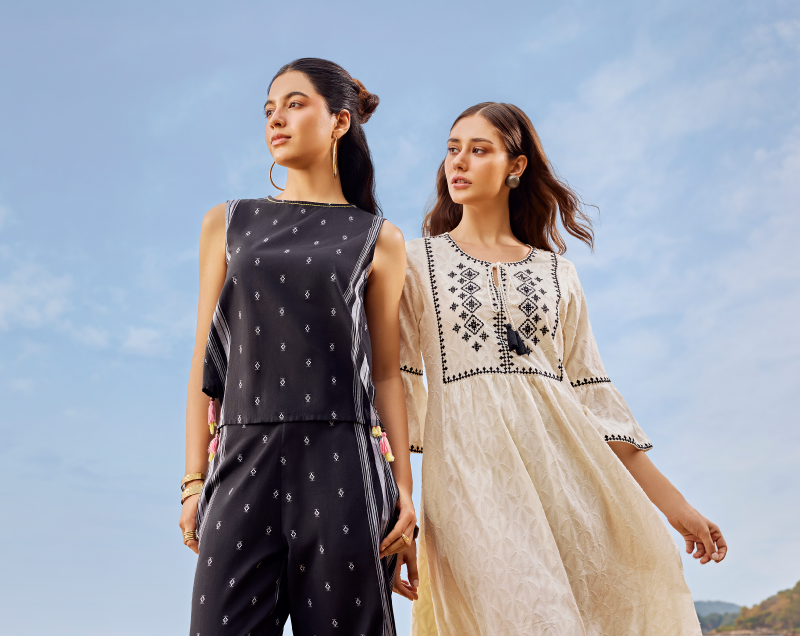TRENDS AND STYLING TIPS FOR WOMEN

TRENDS AND STYLING TIPS FOR WOMEN
As our world changes, the fashion industry is also drastically growing day by day. Women’s clothes change according to the trends in the industry. Women’s fashion content has become a dramatic topic in the world about their styling ways, designs. To create a stylish and flattering look, women can embrace trends while also tailoring them to their body type and personal style. Key styling tips include understanding your body type, accessorising wisely, and staying updated with fashion trends while incorporating timeless pieces.
New trending styles of women are wearing bold colours to emphasise their natural colours. They don’t need to be shy about wearing colours like neon green, Fiery red, etc. Important points for styling are;
- Layering:
Layering adds dimension and warmth to outfits, allowing for versatile styling. - Emphasize the Waist:
Fitted clothing like wrap dresses or pencil skirts, or belts over tops and blazers, can help define the waist and create a more flattering silhouette. - Find Flattering Necklines:
Experiment with different necklines to find those that highlight your features and create balance. - Sustainable Fashion:
Opt for clothing made from eco-friendly materials to stay stylish and environmentally conscious.
In 2025, expect to see a mix of bold and innovative styles, with a focus on sustainability, digital self-expression, and comfort. Key trends include:
Colors:
- Chocolate Brown: A sophisticated substitute for black or charcoal gray, this classic neutral will be a popular color in 2025.
- Shades of Yellow: Bright and vibrant yellow hues are expected to be a major trend, potentially in yellow skirts, tops, or accessories.
- Powder Pink: Soft, pastel pink tones will be a key color for spring and summer 2025.
TOP FASHION TRENDS IN 2025( May be in the future)
- Shades of yellow
- Animal print
- Thongs sandals
- Cute sportswear
- Hots pants
Nowadays, GEN Z Plays an important role in the fashion industry. Their new way of styling dresses stole the eyes of most of the media industry. Upcycled items, gender-neutral designs, wearable technology, and AI-curated ensembles are all part of Gen Z fashion in 2025. Their clothes are dominated by comfort, digital self-expression, and sustainability; producers, not simply designers, are setting the trends.
GEN Z has its unique taste for fashion. They have a unique set of characteristics, including being resilient and flexible. It has exposed them to fresh perspectives on the future and methods of doing things, as well as challenging established practices, which leads to the second characteristic that Gen Zers will bring to the workplace. In addition to embracing earth tones and pastels for a well-balanced style, Gen Z Vibrant and eye-catching hues like neon greens, electric blues, and dazzling pink are common in fashion. . Also in style are muted hues like dusty rose and sage green, which provide a subtle yet elegant look. For Gen Z, yellow is an unofficial color of the year because of its upbeat and cheerful feelings.
SUMMER STYLES TRENDS FOR WOMEN IN 2025
For the summer of 2025, what trends are popular?
Seven Small Trends That Will Add Style to Your Summertime Ensembles. Seven microtrends for Summer 2025 That Will Make Your Clothes Feel Right now.
- Bermudas in white denim.
- prints on bandanas.
- Bangles made of resin.
- Yellow, White, and Black.
- Earrings of starfish.
- Belts for scarves.
- Flip Flops with Studs.
TRENDS OF WOMEN’S CLOTHES IN INDIA
Bright color schemes have long been a hallmark of Indian design, and in 2025, striking hues and prints will rule the runway. Floral Prints: In 2025, floral designs are being reinterpreted for sarees, lehengas, and even casual clothing. They have never truly gone out of vogue. India brings different eye-catching, trending styles in the summer collection in 2025. It brings different styles for women of every age to enjoy trends.
Indian women mostly wear. While many South Indian children typically wear Langa voni, traditional Indian dress for ladies nationwide consists of saris worn with choli tops, a skirt known as a lehenga or chaniya worn with choli, and a dupatta scarf to make an ensemble known as a ghagra choli.
DIFFERENT TRENDS ACCORDING TO INDIAN CULTURES
Cultural and geographical differences have a significant impact on Indian fashion trends, creating a complex and varied tapestry of both traditional and contemporary designs. Every article of clothing, from the classic saree to the adaptable salwar kameez, has a certain cultural meaning and is worn in various ways and with various embellishments in various locales and societies.
REGIONAL STYLES AND INFLUENCES
North India: This region is renowned for its rich Rajput and Mughal influences, and popular fashions include the sherwani, ghagra choli, lehenga, and Anarkali suit.
South India: This region is well-known for its sophisticated sarees, especially the Kanchipuram silk sarees, as well as traditional attire, such as men’s dhoti kurtas.
East India: The Bengali saree and the Mekhela Chador of Assam are two notable examples of the region’s distinctive weaving customs and patterns.
West India: The Patola saree from Gujarat and the Nauvari saree from Maharashtra are examples of West Indian fashion, which was influenced by Portuguese and Parsi designs.
The different areas of India each have unique traditional clothing that is influenced by geography, culture, and climate. Men usually wear dhotis, kurtas, and sherwanis, while women dress in sarees, salwar kameez, ghagra cholis, and mekhala chadors.
Cultural and Religious Influences: Hindu women frequently wear sarees, ghagra cholis, and salwar kameez, while Hindu males typically wear dhotis, kurtas, and lungis. These factors have a big impact on fashion choices.
Muslim women typically dress in salwar kameez with dupattas and burqas.
Mundum neriyathum, also called the set mundu, is a Keralan woman’s traditional dress. Men typically wear a mundu, a piece of cloth wrapped around the waist, and a shirt.
Women’s Traditional Attire (Mundum Neriyathum):
- It’s a two-piece set consisting of a mundu (lower garment, like a skirt) and a neriyathu (upper garment, usually a blouse or jacket).
- The mundu is often worn during special occasions like festivals, weddings, and visits to temples.
- In Kerala, it is especially well-liked among matrilineal communities.
- Kerala’s cultural identity is symbolized by the mundum neriyathum, which combines modernism and tradition.
Another famous item of clothing worn in Kerala on special occasions is the Kasavu saree, which has a border of zari or gold.
Kerala’s traditional dress is heavily influenced by patterns and colors, with vivid hues like red and green being connected to festivities.
Cotton or silk is used to make the traditional clothing, which is appropriate for Kerala’s hot and muggy climate.

